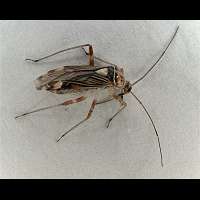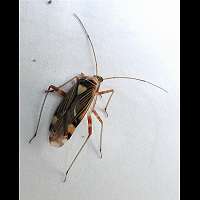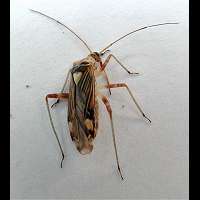Rhabdomiris striatellus
Rhabdomiris striatellus comes in two varieties. The first is the light variety as in the pictures on this page. This light variety is easily identified. There also is a dark variety, which is very similar to Miris striatus, a related species. The neck shield is black with three thin yellow lines. The scutellum is mainly black, only the tip is yellowish. And the uppershields are black with a few yellow lines only. The differences between the two species are easy to see though. On the neck shield Rhabdomiris striatellus has a thin yellow line. Miris striatus has a bigger diamond shaped yellow marking. Miris stratius als has a conspicuous white ring in the middle of the antennae. The antennae of the dark variety of Rhabdomiris striatellus are entirely black. Rhabdomiris striatellus reaches a length of some 7 to 9 mm.
The eggs are being laid in the first part of June mainly. They are deposited in flower buds. And they remain there for a very long time. They overwinter and only hatch in March or April of the next year. The larvae come in two colour schemes: yellow with brown and black markings, or red with white and brown markings. They grow rapidly indeed, sucking on the flowers and freshly developing seeds of the host plant. By the middle of May the first adults appear. The only hostplants of Rhabdomiris striatellus are trees from the genus Quercus, better known as oak.
The adult animals are able flyers and they like to fly. Soon they may be discovered on many plants, not just oak. They are even interested in conifers. This is mainly due to a radical change in diet, for the adults are carnivores, hunting for aphids, the larvae of other bugs and cicadas and the caterpillars of Tortrix Moths. The females have to return to aoks however to deposit their eggs. Males of Rhabdomiris striatellus are short lived. Most of them have died by the middle of June. Females may live to see the mid of July. By the way: this species only needs one oak tree to settle in. A forest with lots of oaks will do too, of course. Rhabdomiris striatellus is common in moderate Europe, Western Asia and the Caucasus. Very common all over Britain near oak.
Until recently this species has been known as Calocoris striatellus. In the past it was also called Calocoris quadripunctatus and Calocoris ochromelas.
Rhabdomiris striatellus comes in two varieties. The first is the light variety as in the pictures on this page. This light variety is easily identified. There also is a dark variety, which is very similar to Miris striatus, a related species. The neck shield is black with three thin yellow lines. The scutellum is mainly black, only the tip is yellowish. And the uppershields are black with a few yellow lines only. The differences between the two species are easy to see though. On the neck shield Rhabdomiris striatellus has a thin yellow line. Miris striatus has a bigger diamond shaped yellow marking. Miris stratius als has a conspicuous white ring in the middle of the antennae. The antennae of the dark variety of Rhabdomiris striatellus are entirely black. Rhabdomiris striatellus reaches a length of some 7 to 9 mm.
The eggs are being laid in the first part of June mainly. They are deposited in flower buds. And they remain there for a very long time. They overwinter and only hatch in March or April of the next year. The larvae come in two colour schemes: yellow with brown and black markings, or red with white and brown markings. They grow rapidly indeed, sucking on the flowers and freshly developing seeds of the host plant. By the middle of May the first adults appear. The only hostplants of Rhabdomiris striatellus are trees from the genus Quercus, better known as oak.
The adult animals are able flyers and they like to fly. Soon they may be discovered on many plants, not just oak. They are even interested in conifers. This is mainly due to a radical change in diet, for the adults are carnivores, hunting for aphids, the larvae of other bugs and cicadas and the caterpillars of Tortrix Moths. The females have to return to aoks however to deposit their eggs. Males of Rhabdomiris striatellus are short lived. Most of them have died by the middle of June. Females may live to see the mid of July. By the way: this species only needs one oak tree to settle in. A forest with lots of oaks will do too, of course. Rhabdomiris striatellus is common in moderate Europe, Western Asia and the Caucasus. Very common all over Britain near oak.
Until recently this species has been known as Calocoris striatellus. In the past it was also called Calocoris quadripunctatus and Calocoris ochromelas.







